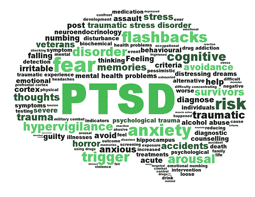Post-Traumatic Stress Disorder, more commonly known as PTSD, was first classified by the American Psychiatric Society in 1980 after conducting studies on Vietnam War veterans. Since then, PTSD has been widely associated with war veterans. The notion that only war veterans can suffer from PTSD, however, is inaccurate. In fact, traffic accidents have become the leading cause of PTSD since the Vietnam war. One estimate states that about 9% of accident survivors develop PTSD, while many more exhibit PTSD-like symptoms. The disorder affects about 7.5 million adults in the United States today.
Table of Contents
What is PTSD?
PTSD is defined as a condition of persistent mental and emotional stress occurring as a result of injury or severe psychological shock, typically involving disturbance of sleep and constant vivid recall of the experience, with dulled responses to others and to the outside world.
What is the Difference Between Emotional or Psychological Trauma and PTSD?
Psychological or emotional trauma and PTSD stem from the same traumatic experience. The main difference between these two, however, is the severity of the symptoms and the length of time for which one suffers from these symptoms. When a person experiences a traumatic event, it is hard to neatly categorize their reaction. Just as every individual is unique, reactions to traumatic experiences are unique as well. Doctors have developed a casual spectrum to help the medical world understand the psychological and emotional effects that others experience after traumatic events. The spectrum (loosely) goes as follows: Stress – Emotional or Psychological Trauma – Acute Stress Disorder (ASD) – Post Traumatic Stress Disorder (PTSD). In other words, PTSD is diagnosed if the stress and trauma symptoms occur over exaggerated periods of time (typically at least three months after the event). Research shows that about 60% of the US population reported as having experienced at least one traumatic symptom in their lives but only a small proportion actually develops PTSD.
Diagnosis and Symptoms
As stated above, not every one who is traumatized develops PTSD. Symptoms usually begin within 3 months of the traumatic incident and must last more than a month in order for an individual to be diagnosed with PTSD. While some individuals recover within months, others have symptoms that last years. In severe cases, the PTSD is chronic.
The primary symptoms of PTSD consist of four main categories:
- Trauma (i.e. intense fear)
- Reliving (i.e. flashbacks)
- Avoidance behavior (i.e. emotional numbing)
- Hypervigilance (i.e. irritability)
Treatments
There are two general treatment approaches for those who suffer from PTSD: psychotherapy or “talk therapy” and medications, or both. Because no two cases of PTSD are exactly the same, the treatments vary case by case. PTSD often means that the person is suffering from other ailments such as:
- panic disorder
- depression
- substance abuse
- suicidal feelings
These conditions also need to be addressed when treating PTSD.
Psychotherapy
Psychotherapy involves talking with a mental health professional to treat a mental illness. It can either be done in a group or one-on-one with a therapist. Typically, the therapy lasts 6-12 weeks but is not limited to such time. Psychotherapies can either focus on the PTSD symptoms themselves, or on the circumstances that surround the patient (i.e. social, family, job-related problems).
There are different types of psychotherapies that are used, including the following:
Somatic Psychotherapies
Somatic, or brain/body, therapies target the brain and our neurological pathways and connections with a hyper-focus on direct sensory experience. Within Somatic Psychotherapies there are specific types:
- Somatic Experiencing
- Hakomi Method
- Somatic Psychology
- Accelerated Experiential Dynamic Psychotherapy (AEDP)
Somatic Experiencing
Somatic Experiencing is a therapy developed by Peter Levine and is evolved from observing how animals “shake off” traumatic experiences and let the body process stress chemicals until they reach normal levels. It takes advantage of the body’s ability to heal itself and moves away from thoughts or memories and toward bodily sensations. Your natural survival instincts help you to recognize the trauma-related energy and tension that your body feels and releases that energy through shaking, crying, or other forms of physical release.
Hakomi Method
This method was developed by Ron Kurtz and is based on five therapeutic principles – Mindfulness, Organicity, Non-Violence, the Mind-Body Connection, and Unity. It is a body-centered approach. The therapist may ask for the client to experiment with small physical gestures in response to thoughts to reprogram the body’s response to the traumatic memories.
Somatic Psychology
Developed by Pat Ogden, this treatment merges somatic therapies, neuroscience, attachment theory, and cognitive approaches, as well as the Hakomi Method. The approach often uses physical expression to process the energy stored in the body following a trauma to reset the neurological system into better balance. For example, a client might push away the bad feelings or memory by physically pushing against a wall or surface to let the body’s neurological and musculature systems reset themselves.
AEDP
The AEDP approach was developed by Diana Fosha, focusing on elements of secure attachment. This talk therapy focuses on the mutual exchange of deeply-seated emotions, bodily awareness and joyous playful exchange.
Other Stress Treatments
- EMDR (Eye Movement Desensitization and Reprocessing) incorporates elements of cognitive-behavioral therapy with eye movements or other forms of rhythmic, left-right stimulation. These back-and-forth eye movements are thought to work by “unfreezing” traumatic memories, allowing them to be resolved.
- Cognitive-behavioral therapy helps you process and evaluate your thoughts and feelings about a trauma. While cognitive-behavioral therapy doesn’t treat the physiological effects of trauma, it can be helpful when used in addition to a body-based therapy such as somatic experiencing or EMDR.
Sources: Helpguide.org, HealingSources, NIMH, and MayoClinic
